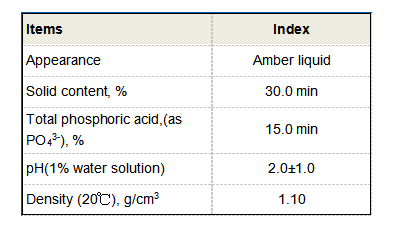Exploring the Properties and Applications of Amino Trimethylene Phosphonic Acid in Various Industries
Amino Trimethylene Phosphonic Acid (ATMP) A Comprehensive Overview
Amino Trimethylene Phosphonic Acid (ATMP) is an organophosphorus compound widely recognized for its chelating properties and applications in various industries. As a phosphonate derivative, ATMP is primarily utilized as a scale inhibitor and dispersant, particularly in water treatment processes. This article delves into the characteristics, synthesis, applications, and advantages of ATMP, solidifying its significance in contemporary manufacturing and environmental management.
Chemical Structure and Properties
ATMP has the chemical formula C4H14N3O9P and is characterized by its unique structure, which includes a phosphonic acid group, an amino group, and a trimethylene backbone. This configuration allows ATMP to effectively bind to metal ions, rendering it an excellent chelator. The presence of amino groups enhances its stability and solubility in various aqueous environments, making it particularly useful in industrial applications.
ATMP is typically supplied as a colorless to yellowish liquid with a low viscosity, and it remains stable under a wide range of environmental conditions. Its pH typically ranges from 1 to 2 in concentrated form, but it can be diluted to suit specific applications. The high solubility of ATMP in water, coupled with its ability to form stable complexes with various metal ions such as calcium, magnesium, and barium, contributes to its efficiency in preventing scale formation.
Synthesis of ATMP
The synthesis of Amino Trimethylene Phosphonic Acid involves several chemical reactions, primarily starting from the reaction of phosphorous acid with amines and formaldehyde. This process yields ATMP through a series of steps that ensure the proper formation of the phosphonic acid groups in conjunction with the amino functionality. As a result, ATMP can be produced with a range of purity levels to accommodate specific industrial needs.
Applications
amino trimethylene phosphonic acid atmp

ATMP’s versatility makes it suitable for a myriad of applications across multiple sectors
1. Water Treatment One of the primary applications of ATMP is in the field of water treatment. It is used as a scale inhibitor in cooling towers, boilers, and heat exchangers. By preventing the precipitation of calcium carbonate and other scales, ATMP contributes to the longevity and efficiency of industrial water systems.
2. Cleaning Agents ATMP is often incorporated into industrial cleaning formulations due to its ability to disperse dirt and prevent mineral buildup. This makes it ideal for use in detergents and other cleaning products.
3. Agriculture In agriculture, ATMP plays a role as a chelating agent in fertilizers, enhancing the availability of micronutrients to plants. This leads to improved plant growth and increased crop yields.
4. Textile Industry The textile industry utilizes ATMP in dyeing processes, where it helps in controlling the distribution of dyes and preventing the formation of metal ion complexes that may adversely affect color quality.
Environmental Considerations and Advantages
ATMP is recognized for its low toxicity and biodegradability compared to other phosphonates. As environmental regulations become increasingly stringent, manufacturers favoring the use of more environmentally friendly chemicals benefit from incorporating ATMP into their processes. The compound assists in reducing water wastage by minimizing scale-related maintenance, further underscoring its environmental credibility.
In conclusion, Amino Trimethylene Phosphonic Acid is a crucial compound in modern industrial applications, particularly in water treatment and agricultural sectors. Its chelating properties, combined with its low environmental impact, underscore its importance as a sustainable option in various applications. As industries evolve to meet regulatory demands and environmental challenges, the role of ATMP is likely to expand, solidifying its significance in advancing both industrial efficiency and environmental stewardship.
-
Water Treatment with Flocculant Water TreatmentNewsJun.12,2025
-
Polymaleic AnhydrideNewsJun.12,2025
-
Polyaspartic AcidNewsJun.12,2025
-
Enhance Industrial Processes with IsothiazolinonesNewsJun.12,2025
-
Enhance Industrial Processes with PBTCA SolutionsNewsJun.12,2025
-
Dodecyldimethylbenzylammonium Chloride SolutionsNewsJun.12,2025





